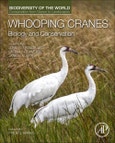Whooping Cranes: Biology and Conservation covers one of the most endangered birds in North America, and the subject of intense research and highly visible conservation activity. The volume summarizes current biological information on Whooping Cranes and provides the basis for future research necessary for conservation of this species.
This edited volume concentrates on work completed in the past 20 years in the areas of population biology, behavior and social structure, habitat use, disease and health, captive breeding, and Whooping Crane conservation. Much of the information presented comes from the study and management of remnant and reintroduced populations of Whooping Cranes in the field; some information is from experimentation and breeding of captive Whooping Cranes.
Whooping Cranes: Biology and Conservation seeks to inform and galvanize action dedicated to meeting the challenges faced by Whooping Crane managers and conservationists. Thus, it describes one model of endangered species conservation and restoration that will interest a wide audience: professionals that work on cranes; researchers in the fields of small population biology, endangered species, and avian ecology; wildlife veterinarians and those involved in avian husbandry; administrators of management agencies or conservation organizations; conservationists in other fields; teachers of conservation biology or ornithology and their students; and the educated general public.
Please Note: This is an On Demand product, delivery may take up to 11 working days after payment has been received.
This edited volume concentrates on work completed in the past 20 years in the areas of population biology, behavior and social structure, habitat use, disease and health, captive breeding, and Whooping Crane conservation. Much of the information presented comes from the study and management of remnant and reintroduced populations of Whooping Cranes in the field; some information is from experimentation and breeding of captive Whooping Cranes.
Whooping Cranes: Biology and Conservation seeks to inform and galvanize action dedicated to meeting the challenges faced by Whooping Crane managers and conservationists. Thus, it describes one model of endangered species conservation and restoration that will interest a wide audience: professionals that work on cranes; researchers in the fields of small population biology, endangered species, and avian ecology; wildlife veterinarians and those involved in avian husbandry; administrators of management agencies or conservation organizations; conservationists in other fields; teachers of conservation biology or ornithology and their students; and the educated general public.
Please Note: This is an On Demand product, delivery may take up to 11 working days after payment has been received.
Table of Contents
1. Whooping Cranes Past and Present2. Phylogenetic Taxonomy of Cranes and the Evolutionary Origin of the Whooping Crane
3. Revisiting the Historic Distribution and Habitats of the Whooping Crane
4. Population and Breeding Range Dynamics in the Aransas-Wood Buffalo Whooping Crane Population
5. Monitoring Recruitment and Abundance of the Aransas-Wood Buffalo Population of Whooping Cranes: 1950-2015
6. Mortality in Aransas-Wood Buffalo Whooping Cranes: Timing, Location, and Causes
7. Population Dynamics of Reintroduced Whooping Cranes
8. Reproductive Failure in the Eastern Migratory Population: The Interaction of Research and Management
9. Florida's Nonmigratory Whooping Cranes
10. Pairing Dynamics of Reintroduced Migratory Whooping Cranes
11. Movement Ecology of Reintroduced Migratory Whooping Cranes
12. Ecological Energetics of Whooping Cranes in the Eastern Migratory Population
13. Winter Habitat Ecology, Use, and Availability for the Aransas wood Buffalo Population of Whooping Cranes
14. Habitat Use by the Reintroduced Eastern Migratory Population of Whooping Cranes
15. Ecological Implications of Habitat Use by Reintroduced and Remnant Whooping Crane Populations
16. Advances in Conservation Breeding and Management of Whooping Cranes (Grus americana)
17. Reproduction and Reproductive Strategies Relevant to Management of Whooping Cranes Ex Situ
18. Health of Whooping Cranes in the Central Flyway
19. Health and Disease Treatment in Captive and Reintroduced Whooping Cranes
20. Rearing and Release Methods for Reintroduction of Captive-Reared Whooping Cranes
21. The Operation of an Aircraft-led Migration: Goals, Successes, Challenges 2001-2015
22. Louisiana Non-migratory Whooping Crane Reintroduction
23. Whooping Crane Shootings since 1967
24. Future of Whooping Crane Conservation and Science








